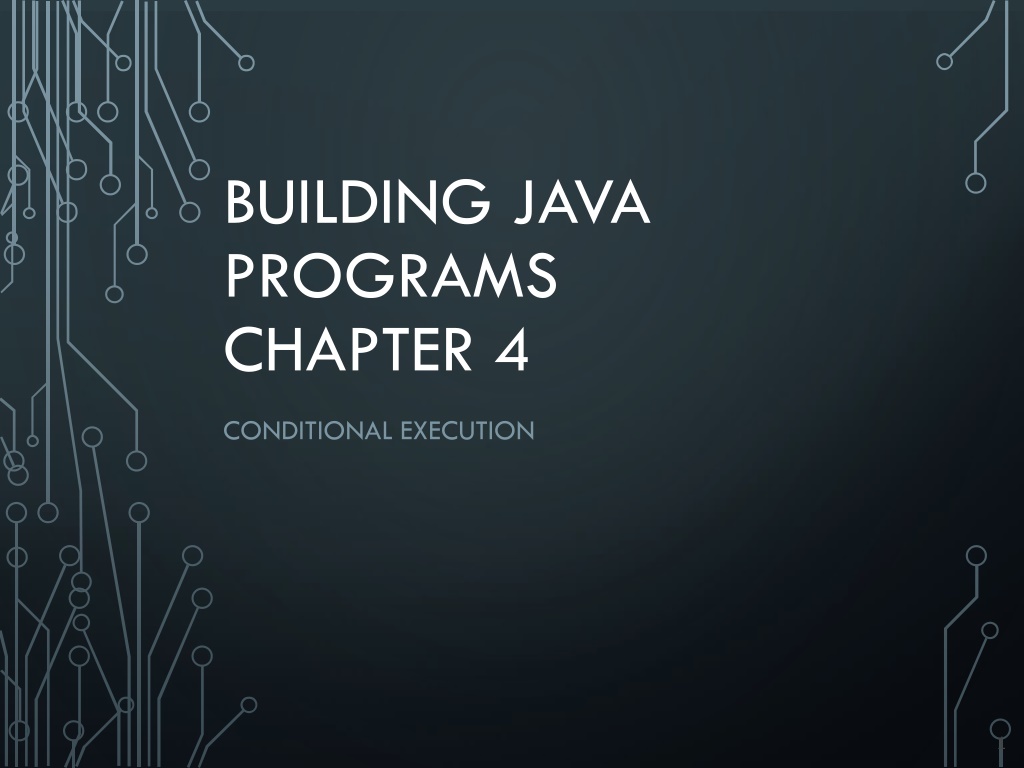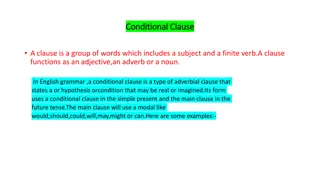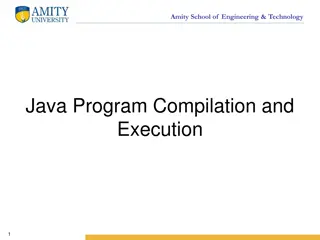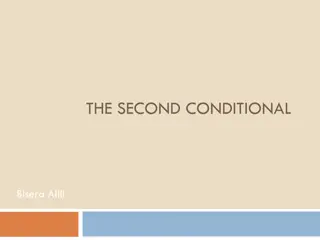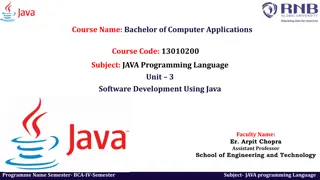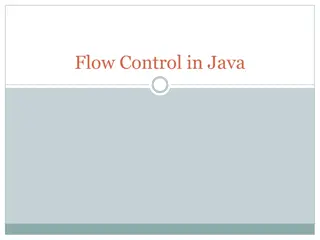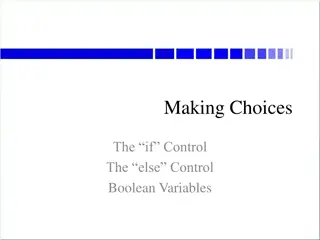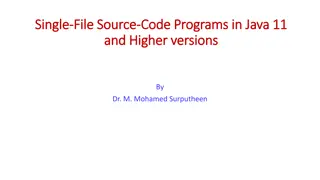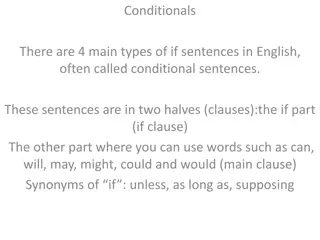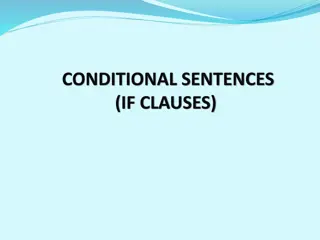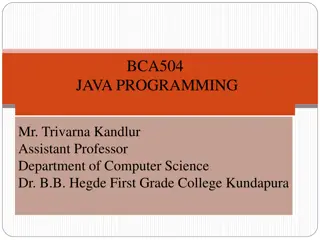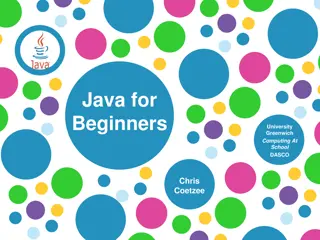Understanding Conditional Execution in Java Programming
Explore the concept of conditional execution in Java programming with if/else statements, relational expressions, and misuse examples. Discover nested if/else structures and their application in decision-making logic. Enhance your understanding of executing code based on specific conditions.
Download Presentation

Please find below an Image/Link to download the presentation.
The content on the website is provided AS IS for your information and personal use only. It may not be sold, licensed, or shared on other websites without obtaining consent from the author. Download presentation by click this link. If you encounter any issues during the download, it is possible that the publisher has removed the file from their server.
E N D
Presentation Transcript
BUILDING JAVA PROGRAMS CHAPTER 4 CONDITIONAL EXECUTION 1
THE IF STATEMENT Executes a block of statements only if a test is true if (test) { statement; ... statement; } Example: double gpa = console.nextDouble(); if (gpa >= 2.0) { System.out.println("Application accepted."); } 3
THE IF/ELSE STATEMENT Executes one block if a test is true, another if false if (test) { statement(s); } else { statement(s); } Example: double gpa = console.nextDouble(); if (gpa >= 2.0) { System.out.println("Welcome to Mars University!"); } else { System.out.println("Application denied."); } 4
RELATIONAL EXPRESSIONS if statements and for loops both use logical tests. for (int i = 1; i <= 10; i++) { ... if (i <= 10) { ... These are boolean expressions, seen in Ch. 5. Tests use relational operators as seen next 5
RELATIONAL EXPRESSIONS CONT. Operator Meaning Example Value equals == 1 + 1 == 2 true does not equal != 3.2 != 2.5 true less than < 10 < 5 false greater than > 10 > 5 true less than or equal to <= 126 <= 100 false greater than or equal to >= 5.0 >= 5.0 true 6
MISUSE OF IF What's wrong with the following code? Scanner console = new Scanner(System.in); System.out.print("What percentage did you earn? "); int percent = console.nextInt(); if (percent >= 90) { System.out.println("You got an A!"); } if (percent >= 80) { System.out.println("You got a B!"); } if (percent >= 70) { System.out.println("You got a C!"); } if (percent >= 60) { System.out.println("You got a D!"); } if (percent < 60) { System.out.println("You got an F!"); } ... 7
NESTED IF/ELSE Chooses between outcomes using many tests if (test) { statement(s); } else if (test) { statement(s); } else { statement(s); } Example: if (x > 0) { System.out.println("Positive"); } else if (x < 0) { System.out.println("Negative"); } else { System.out.println("Zero"); } 8
NESTED IF/ELSE/IF If it ends with else, exactly one path must be taken. If it ends with if, the code might not execute any path. if (test) { statement(s); } else if (test) { statement(s); } else if (test) { statement(s); } Example: if (place == 1) { System.out.println("Gold medal!"); } else if (place == 2) { System.out.println("Silver medal!"); } else if (place == 3) { System.out.println("Bronze medal."); } 9
NESTED IF STRUCTURES exactly 1 path (mutually exclusive) 0 or 1 path (mutually exclusive) if (test) { statement(s); } else if (test) { statement(s); } else { statement(s); } if (test) { statement(s); } else if (test) { statement(s); } else if (test) { statement(s); } 0, 1, or many paths (independent tests; not exclusive) if (test) { statement(s); } if (test) { statement(s); } if (test) { statement(s); } 10
WHICH NESTED IF/ELSE? (1)if/if/if (2) nested if/else (3) nested if/else/if Whether a user is lower, middle, or upper-class based on income. (2) nested if / else if / else Whether you made the dean's list (GPA 3.8) or honor roll (3.5-3.8). (3) nested if / else if Whether a number is divisible by 2, 3, and/or 5. (1) sequential if / if / if Computing a grade of A, B, C, D, or F based on a percentage. (2) nested if / else if / else if / else if / else 11
NESTED IF/ELSE QUESTION Formula for body mass index (BMI): BMI Weight class underweight normal overweight obese below 18.5 18.5 - 24.9 25.0 - 29.9 30.0 and up weight =height 2 703 BMI Write a program that produces output like the following: This program reads data for two people and computes their body mass index (BMI). Enter next person's information: height (in inches)? 70.0 weight (in pounds)? 194.25 Enter next person's information: height (in inches)? 62.5 weight (in pounds)? 130.5 Person 1 BMI = 27.868928571428572 overweight Person 2 BMI = 23.485824 normal Difference = 4.3831045714285715 12
NESTED IF/ELSE ANSWER // This program computes two people's body mass index (BMI) // and compares them. The code uses Scanner for input, and // parameters/returns. import java.util.*; // so that I can use Scanner public class BMI { public static void main(String[] args) { introduction(); Scanner console = new Scanner(System.in); double bmi1 = person(console); double bmi2 = person(console); // report overall results report(1, bmi1); report(2, bmi2); System.out.println("Difference = " + Math.abs(bmi1 - bmi2)); } 13
NESTED IF/ELSE, CONT'D. // reads information for one person, computes their BMI, and // returns it public static double person(Scanner console) { System.out.println("Enter next person's information:"); System.out.print("height (in inches)? "); double height = console.nextDouble(); System.out.print("weight (in pounds)? "); double weight = console.nextDouble(); System.out.println(); double bodyMass = bmi(height, weight); return bodyMass; } // prints a welcome message explaining the program public static void introduction() { System.out.println("This program reads data for two + people and"); System.out.println("computes their body mass index + (BMI)."); System.out.println(); } ... 14
NESTED IF/ELSE, CONT'D. // Computes/returns a person's BMI based on their height and // weight. public static double bmi(double height, double weight) { return (weight * 703 / height / height); } // Outputs information about a person's BMI and weight status. public static void report(int number, double bmi) { System.out.println("Person " + number + " BMI = " + bmi); if (bmi < 18.5) { System.out.println("underweight"); } else if (bmi < 25) { System.out.println("normal"); } else if (bmi < 30) { System.out.println("overweight"); } else { System.out.println("obese"); } } } 15
LOGICAL OPERATORS Tests can be combined using logical operators: Operator && || ! Description and or not Example Result (2 == 3) && (-1 < 5) false (2 == 3) || (-1 < 5) !(2 == 3) true true 16
TRUTH TABLES "Truth tables" for each, used with logical values p and q: p && q true p || q true true true false p q !p true true false true false false false true false false p true false true false false 17
EVALUATING LOGIC EXPRESSIONS Relational operators have lower precedence than math. 5 * 7 >= 3 + 5 * (7 - 1) 5 * 7 >= 3 + 5 * 6 35 >= 3 + 30 35 >= 33 true Relational operators cannot be "chained" as in algebra. 2 <= x <= 10 true <= 10 error! (assume that x is 15) Instead, combine multiple tests with && or || 2 <= x && x <= 10 true && false false 18
LOGICAL QUESTIONS What is the result of each of the following expressions? int x = 42; int y = 17; int z = 25; y < x && y <= z x % 2 == y % 2 || x % 2 == z % 2 x <= y + z && x >= y + z !(x < y && x < z) (x + y) % 2 == 0 || !((z - y) % 2 == 0) Answers: true, false, true, true, false Exercise: Write a program that prompts for information about a person and uses it to decide whether to date them. 19
FACTORING IF/ELSE CODE factoring: Extracting common/redundant code. Can reduce or eliminate redundancy from if/else code. Example: if (a == 1) { System.out.println(a); x = 3; b = b + x; System.out.println(a); x = 3 * a; if (a == 2) { y = y + 10; } b = b + x; } else if (a == 2) { System.out.println(a); x = 6; y = y + 10; b = b + x; } else { // a == 3 System.out.println(a); x = 9; b = b + x; } 20
IF/ELSE WITH RETURN // Returns the larger of the two given integers. public static int max(int a, int b) { if (a > b) { return a; } else { return b; } } Methods can return different values using if/else Whichever path the code enters, it will return that value. Returning a value causes a method to immediately exit. All paths through the code must reach a return statement. 21
ALL PATHS MUST RETURN public static int max(int a, int b) { if (a > b) { return a; } // Error: not all paths return a value } The following also does not compile: public static int max(int a, int b) { if (a > b) { return a; } else if (b >= a) { return b; } // Error: not all paths return a value } The compiler thinks if/else/if code might skip all paths, even though mathematically it must choose one or the other. 22
IF/ELSE, RETURN QUESTION Write a method quadrant that accepts a pair of real numbers x and y and returns the quadrant for that point: y+ quadrant 1 quadrant 2 x- x+ quadrant 3 quadrant 4 y- Example: quadrant(-4.2, 17.3) returns 2 If the point falls directly on either axis, return 0. 23
IF/ELSE, RETURN ANSWER public static int quadrant(double x, double y) { if (x > 0 && y > 0) { return 1; } else if (x < 0 && y > 0) { return 2; } else if (x < 0 && y < 0) { return 3; } else if (x > 0 && y < 0) { return 4; } else { // at least one coordinate equals 0 return 0; } } 24
